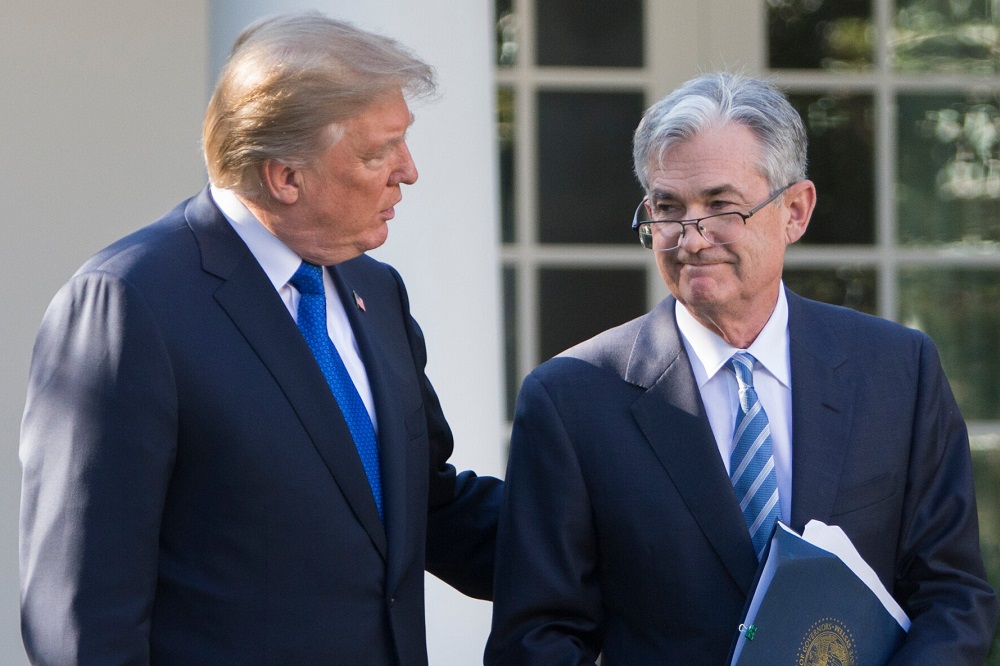Political pressure on the Fed to ease monetary policy
Many analysts are pretty sure that Fed Chair Powell won’t say this at Friday’s Jackson Hole symposium that the Fed has been put in an impossible position by politics. But it may have.

US President Donald Trump has pressed Fed Chair Powell to cut rates
First up, tariffs imply weaker growth and higher iinflation, a nightmare for the Fed. But layered on top of this is political pressure from the Trump Administration to cut rates. It is hard to see how the Fed can come out of this with its credibility intact and that could weigh on US asset prices.
The stagflationary threat from US tariffs is the first priority of the Fed. The US economy seems to be weakening, at least as judged by the labour market, but inflation is stubbornly above target and likely to rise further as US firms pass on more of their cost increases to consumers. On this basis, you could make a case for the Fed to both cut and hike rates. Of course, the Fed has done neither; instead preferring to wait to see which side of its dual inflation/employment mandate is most at risk.
Undoubtedly, the employment side of the mandate seems to be gaining in prominence with the two dissenters at the last FOMC meeting preferring a rate cut to address rising labour market fragility. Add to this the fact that the current Fed funds target rate of 4.25%-4.50% is regarded as restrictive by the Fed and it seems clear that Fed is more disposed to cut rates than hike, possibly as soon as next month. But will a cut at this juncture enhance its standing with the market?
Steven Barrow, Head of Standard Bank G10 Strategy, said it is probably not. For the Fed will presumably be cutting rates at a time when inflation is rising and, while members might see tariffs as a one-time inflation shock, members cannot be sure of that. The last time, Fed Chair Powell said that a rise in inflation was “transitory”, in 2021 he had to eat his words as inflation soared and the Fed was forced to hike rates by 425-bps. That episode damaged the Fed’s credibility which was bad for bonds but not necessarily the US dollar because other central banks made the same mistake. Fast-forward to today and the inflationary impact of tariffs in the US could conceivably single out the Fed for a credibility hit as other countries are more likely to experience a fall in inflation than a rise. If that’s the case, the dollar is more likely to take a hit than last time.
But layered on top of the Fed’s stagflationary problem is the political pressure to ease policy. Of course, it is not unusual to see President Trump call for lower interest rates; he did it during his first term. But that was not long after Trump re-appointed Powell as Fed chair. Today he has the power to refuse his reappointment next May when Powell’s term expires and we know that Trump will choose another candidate. Hence, there is far more political pressure this time around and it does not just stop at Powell.
There also seems to be pressure from within the Fed as the two dissenters to the last Fed decision to leave rates unchanged were Waller and Bowman; both considered to be candidates for the top job. Others that seem to be in the frame for Powell’s job also appear to be displaying similar enthusiasm for rate cuts. These include the National Economic Council head Stephen Miran who could find himself on the FOMC for the September meeting to replace departing Governor Kugler.
In short, a political bias for looser policy is coming the Fed’s way. Of course, we could argue that the likes of Bowman and Waller have only switched to a bias for immediate rate cuts because the employment outlook has deteriorated. But Steven Barrow suspects that they will stick to a call for rate cuts even if labour market data improves, and even if inflation rises by more than anticipated. The same goes for Miran if, and when, he joins the FOMC. Will the Fed’s impossible position weigh on US assets like bonds and stocks?
In Steven Barrow’s opinion, the judge and jury will be the data. If the labour market softens much more and inflation stays only moderately above target, the bond (and currency) vigilantes will give the Fed the benefit of the doubt. The danger arises if the data do not support the case for rate cuts but the Fed goes ahead regardless and, right now, this is the more likely scenario.








